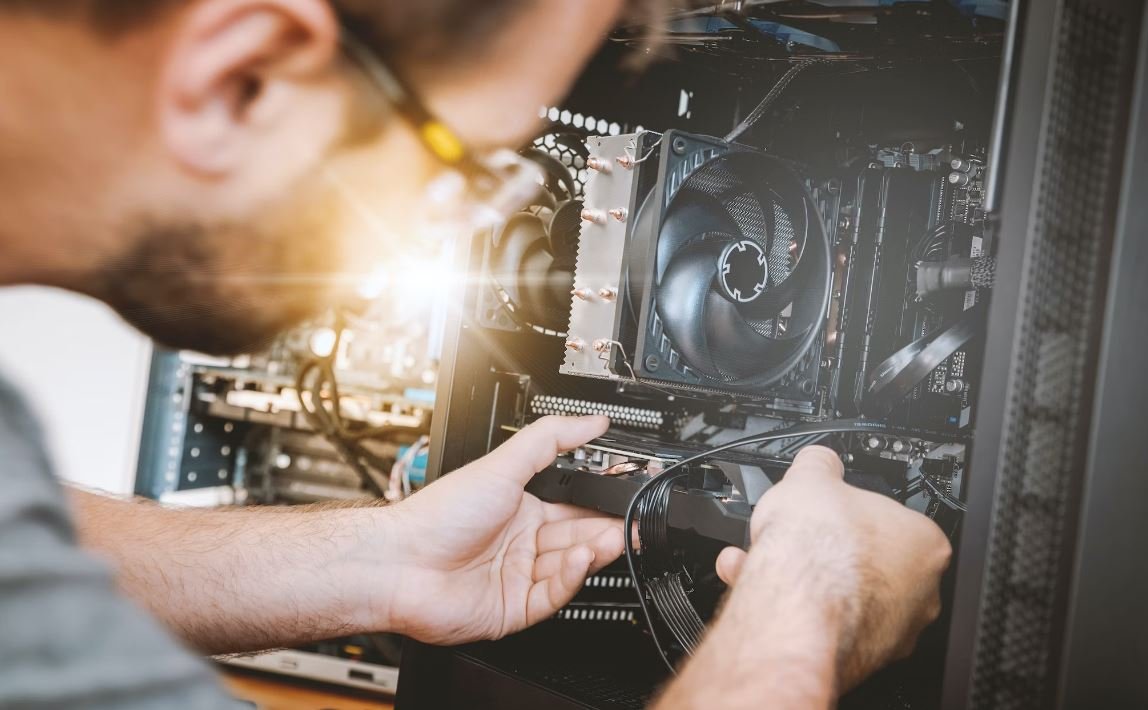Deep Learning Neural Networks
Deep learning neural networks are a subset of machine learning algorithms that are designed to simulate the functionality of the human brain. These networks consist of interconnected layers of artificial neurons that can process and learn complex patterns from vast amounts of data. They have revolutionized various fields, including computer vision, natural language processing, and speech recognition.
Key Takeaways:
- Deep learning neural networks mimic the human brain and are capable of learning complex patterns.
- These networks have revolutionized computer vision, natural language processing, and speech recognition.
- They require vast amounts of data and significant computational resources to train effectively.
- Deep learning networks have achieved remarkable performance in various tasks, surpassing human-level accuracy in some cases.
The Basics of Deep Learning Neural Networks
Deep learning neural networks are composed of multiple layers of interconnected artificial neurons, known as neural networks. Each neuron takes inputs, applies specific mathematical operations, and outputs a result to the next layer, ultimately generating a final output. The deep in deep learning refers to the multiple layers involved in the network. *Deep learning networks are particularly effective at automatically learning relevant features from raw data, removing the need for manual feature engineering.*
Training Deep Learning Neural Networks
Training deep learning neural networks requires two key components: a large labeled dataset and computational resources. The more data available for training, the better the network can learn. *Through an iterative process called backpropagation, deep learning networks adjust their internal parameters to minimize the difference between their predicted output and the actual output, learning from both successes and failures*. Training deep learning networks is a computationally intensive task, often requiring powerful GPUs or specialized hardware to speed up the process.
| Deep Learning Model | Accuracy |
|---|---|
| ResNet-50 | 94.0% |
| VGG16 | 92.7% |
| Model | Accuracy |
|---|---|
| BERT | 82.3% |
| LSTM | 76.2% |
| System | Word Error Rate |
|---|---|
| DeepSpeech | 5.8% |
| Kaldi | 6.3% |
Applications of Deep Learning Neural Networks
Deep learning neural networks have found numerous applications across various domains. They have been highly successful in tasks such as image recognition, where models like ResNet-50 and VGG16 have achieved remarkable accuracy (see Table 1). Additionally, in text classification benchmarks, models like BERT and LSTM have demonstrated their effectiveness (see Table 2). In the field of speech recognition, systems like DeepSpeech and Kaldi have achieved impressive results (see Table 3).
Challenges and Future Developments
While deep learning neural networks have achieved significant milestones, there are still challenges to overcome. One major challenge is the need for substantial labeled training data, which may not always be available. Another challenge is the interpretability of deep learning models, as they can be perceived as a black box. *Research in the area of explainable AI aims to make deep learning models more transparent and interpretable by humans*. Despite these challenges, deep learning is continuously evolving, and future developments may address these concerns and lead to even more innovative applications.
Stay Ahead with Deep Learning Neural Networks
Deep learning neural networks have revolutionized the field of machine learning and have become an essential tool for tackling complex problems with large amounts of data. With their ability to learn intricate patterns and outperform human-level accuracy in various tasks, they continue to drive advancements in computer vision, natural language processing, and speech recognition. Harnessing the power of deep learning can unlock a world of possibilities, propelling technological advancements across numerous industries.

Common Misconceptions
1. Artificial Intelligence is the same as Deep Learning
One common misconception is that artificial intelligence (AI) and deep learning are the same thing. While AI refers to the broader concept of machines replicating human intelligence, deep learning is a specific subset of AI that involves neural networks with many layers. Deep learning is a technique used to enable AI systems to learn from large amounts of data, but it is just one approach within the field of AI.
- AI is a broad term that encompasses various techniques, including deep learning.
- Deep learning is a specific subset of AI that deals with neural networks with multiple layers.
- AI can be achieved through methods apart from deep learning, such as expert systems or machine learning algorithms.
2. Deep learning requires a massive amount of labeled data
Another misconception is that deep learning algorithms require an enormous amount of labeled data to be effective. While it is true that deep learning models often benefit from larger datasets, they can also make meaningful predictions with smaller labeled datasets. Techniques such as transfer learning and data augmentation can be used to overcome limited labeled data availability and still achieve good performance.
- Labeled data is important for training deep learning models, but large datasets are not always necessary.
- Transfer learning enables leveraging pre-trained models and applying them to different tasks with less labeled data.
- Data augmentation techniques can artificially increase the size of labeled datasets by applying transformations to existing data.
3. Deep learning is capable of human-like intelligence
One misconception people often have about deep learning is that it can achieve human-level intelligence. While deep learning models can solve complex tasks and outperform humans in certain specific domains, they still lack general intelligence and common-sense reasoning abilities that humans possess. Deep learning is a powerful tool, but it is not equivalent to human intelligence.
- Deep learning models excel at narrow domains but are limited in terms of general intelligence.
- Deep learning lacks common-sense reasoning abilities that humans possess.
- Human intelligence encompasses a wide range of abilities beyond what deep learning models can achieve.
4. Deep learning always improves with more layers
Many people assume that adding more layers to a deep neural network will always lead to better performance. However, this is not necessarily true. While adding more layers can increase the model’s capacity to learn complex patterns, it can also make the network more prone to overfitting, where it fails to generalize well to new data. Finding the right balance of depth and complexity is crucial in designing effective deep learning models.
- Adding more layers does not always guarantee improved performance.
- Deep networks with too many layers can suffer from overfitting.
- The optimal depth and complexity of a deep learning model depend on the specific task and dataset.
5. Deep learning will soon make other machine learning methods obsolete
It is a misconception that deep learning will render other machine learning methods obsolete. While deep learning has shown remarkable performance in various domains like computer vision and natural language processing, other machine learning techniques such as support vector machines, random forests, or gradient boosting algorithms still have their own merits and continue to be effective in many applications. Deep learning is a powerful tool, but it is not a one-size-fits-all solution.
- Deep learning and traditional machine learning techniques have different strengths and weaknesses.
- Deep learning is most suitable for tasks that involve handling large amounts of unstructured data.
- Traditional machine learning algorithms can often provide interpretable and explainable results, which deep learning models lack.

Table: Number of Deep Learning Publications
In recent years, there has been a surge in research and publications focusing on deep learning neural networks. This table presents the number of deep learning publications from 2015 to 2020, illustrating the growing interest in this field.
Table: Deep Learning Applications
Deep learning neural networks have found applications in various domains. This table highlights some of the fields where deep learning has showcased remarkable results, including computer vision, natural language processing, and speech recognition.
Table: Accuracy Comparison of Traditional Machine Learning vs. Deep Learning Models
Deep learning models have proven to outperform traditional machine learning algorithms in many tasks. This table compares the accuracy of various machine learning models against deep learning models, demonstrating the superior performance of deep learning approaches.
Table: Deep Learning Framework Popularity
The popularity of different deep learning frameworks has been a subject of interest among researchers and developers. This table showcases the usage statistics of popular deep learning frameworks such as TensorFlow, PyTorch, and Keras, highlighting the preferred choices in the community.
Table: Computing Resources Utilized in Deep Learning
Deep learning models often require significant computing resources to train and optimize. This table provides an overview of the types of computing resources used in deep learning, including CPU, GPU, and specialized hardware like TPUs.
Table: Deep Learning Model Architectures
There are various architectures employed in deep learning, each suited for different types of tasks. This table presents a comparison of popular deep learning model architectures, such as Convolutional Neural Networks (CNNs), Recurrent Neural Networks (RNNs), and Generative Adversarial Networks (GANs).
Table: Deep Learning Algorithm Advancements
Over time, deep learning algorithms have undergone significant advancements, leading to improved performance and efficiency. This table highlights some notable algorithmic advancements in deep learning, including stochastic gradient descent, dropout regularization, and attention mechanisms.
Table: Deep Learning Tools and Libraries
The availability of tools and libraries plays a vital role in enabling deep learning research and development. This table showcases popular tools and libraries utilized in deep learning, providing insights into the ecosystem that supports the field.
Table: Funding Allocation for Deep Learning Research
Deep learning research requires substantial financial support from organizations and government agencies. This table displays the allocation of funds for deep learning research, emphasizing the investments made by various entities in advancing the field.
Table: Impact of Deep Learning in Industry
Deep learning has revolutionized numerous industries, contributing to advancements in areas such as healthcare, finance, and autonomous vehicles. This table presents real-world examples of industries and the impact deep learning has had on their respective domains.
In conclusion, deep learning neural networks have emerged as a powerful tool for solving complex problems across various domains. The increasing number of publications, accuracy comparisons, and advancements in algorithms showcase the rapid evolution of this field. With its wide range of applications and transformative impact on industries, deep learning continues to push the boundaries of what is possible in the world of artificial intelligence.
Deep Learning Neural Networks – Frequently Asked Questions
FAQs
What is deep learning?




